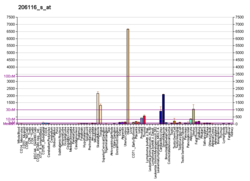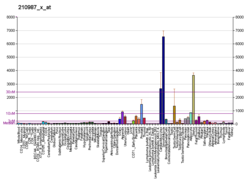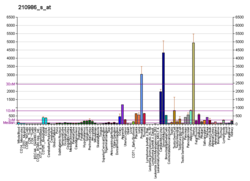TPM1
Tropomyosin alpha-1 chain is a protein that in humans is encoded by the TPM1 gene.[5] This gene is a member of the tropomyosin (Tm) family of highly conserved, widely distributed actin-binding proteins involved in the contractile system of striated and smooth muscles and the cytoskeleton of non-muscle cells.
Structure
Tm is a 32.7 kDa protein composed of 284 amino acids.[6] Tm is a flexible protein homodimer or heterodimer composed of two alpha-helical chains, which adopt a bent coiled coil conformation to wrap around the seven actin molecules in a functional unit of muscle.[7] It is polymerized end to end along the two grooves of actin filaments and provides stability to the filaments. Human striated muscles express protein from the TPM1 (α-Tm), TPM2 (β-Tm) and TPM3 (γ-Tm) genes, with α-Tm being the predominant isoform in striated muscle. In human cardiac muscle the ratio of α-Tm to β-Tm is roughly 5:1.[8]
Function
Tm functions in association with the troponin complex to regulate the calcium-dependent interaction of actin and myosin during muscle contraction. Tm molecules are arranged head-to-tail along the actin thin filament, and are a key component in cooperative activation of muscle. A three state model has been proposed by McKillop and Geeves,[9] which describes the positions of Tm during a cardiac cycle. The blocked (B) state occurs in diastole when intracellular calcium is low and Tm blocks the myosin binding site on actin. The closed (C) state is when Tm is positioned on the inner groove of actin; in this state myosin is in a "cocked" position where heads are weakly bound and not generating force. The myosin binding (M) state is when Tm is further displaced from actin by myosin crossbridges that are strongly-bound and actively generating force. In addition to actin, Tm binds troponin T (TnT). TnT tethers the region of head-to-tail overlap of subsequent Tm molecules to actin.
Clinical Significance
Mutations in TPM1 have been associated with hypertrophic cardiomyopathy (HCM) and dilated cardiomyopathy. HCM mutations tend to cluster around the N-terminal region and a primary actin binding region known as period 5.[10]
References
- ^ a b c GRCh38: Ensembl release 89: ENSG00000140416 – Ensembl, May 2017
- ^ a b c GRCm38: Ensembl release 89: ENSMUSG00000032366 – Ensembl, May 2017
- ^ "Human PubMed Reference:". National Center for Biotechnology Information, U.S. National Library of Medicine.
- ^ "Mouse PubMed Reference:". National Center for Biotechnology Information, U.S. National Library of Medicine.
- ^ Mogensen J, Kruse TA, Borglum AD (Jun 1999). "Refined localization of the human alpha-tropomyosin gene (TPM1) by genetic mapping". Cytogenet Cell Genet. 84 (1–2): 35–6. doi:10.1159/000015207. PMID 10343096.
- ^ http://www.heartproteome.org/copa/ProteinInfo.aspx?QType=Protein%20ID&QValue=P09493.
{{cite web}}: Missing or empty|title=(help) - ^ Brown, J. H.; Kim, K. H.; Jun, G; Greenfield, N. J.; Dominguez, R; Volkmann, N; Hitchcock-Degregori, S. E.; Cohen, C (2001). "Deciphering the design of the tropomyosin molecule". Proceedings of the National Academy of Sciences. 98 (15): 8496–501. doi:10.1073/pnas.131219198. PMC 37464. PMID 11438684.
- ^ Yin, Z; Ren, J; Guo, W (2015). "Sarcomeric protein isoform transitions in cardiac muscle: A journey to heart failure". Biochimica et Biophysica Acta (BBA) - Molecular Basis of Disease. 1852 (1): 47–52. doi:10.1016/j.bbadis.2014.11.003. PMC 4268308. PMID 25446994.
- ^ McKillop, D. F.; Geeves, M. A. (1993). "Regulation of the interaction between actin and myosin subfragment 1: Evidence for three states of the thin filament". Biophysical Journal. 65 (2): 693–701. doi:10.1016/S0006-3495(93)81110-X. PMC 1225772. PMID 8218897.
- ^ Tardiff, J. C. (2011). "Thin filament mutations: Developing an integrative approach to a complex disorder". Circulation Research. 108 (6): 765–82. doi:10.1161/CIRCRESAHA.110.224170. PMC 3075069. PMID 21415410.
Further reading
External links
- Mass spectrometry characterization of human TPM1 at COPaKB [1]
- GeneReviews/NIH/NCBI/UW entry on Familial Hypertrophic Cardiomyopathy Overview
- ^ Zong, N. C.; Li, H; Li, H; Lam, M. P.; Jimenez, R. C.; Kim, C. S.; Deng, N; Kim, A. K.; Choi, J. H.; Zelaya, I; Liem, D; Meyer, D; Odeberg, J; Fang, C; Lu, H. J.; Xu, T; Weiss, J; Duan, H; Uhlen, M; Yates Jr, 3rd; Apweiler, R; Ge, J; Hermjakob, H; Ping, P (2013). "Integration of cardiac proteome biology and medicine by a specialized knowledgebase". Circulation Research. 113 (9): 1043–53. doi:10.1161/CIRCRESAHA.113.301151. PMC 4076475. PMID 23965338.
{{cite journal}}: CS1 maint: numeric names: authors list (link)











